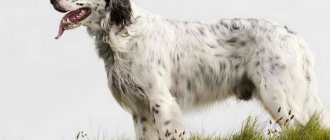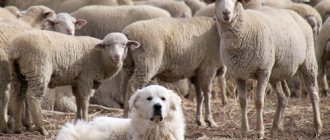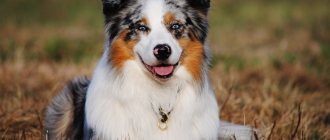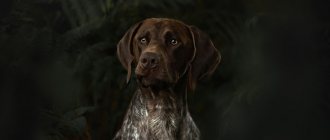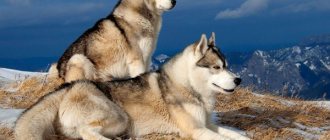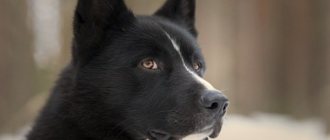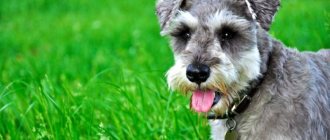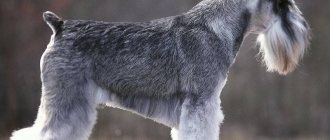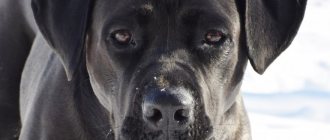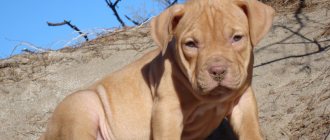The Miniature Schnauzer dog is a small animal with a big and kind heart. It is always in the top 20 most popular breeds in the USA, England and Germany, but is bred all over the world. She is a "friend of people" and a moderately high energy extrovert who is constantly looking to have fun. And you will never get bored with her. She is incredibly loyal to her family and needs a lot of attention.
The Miniature Schnauzer dog is a small animal with a big and kind heart.
Breed standards and description
Height at withers: 30-35 cm; Weight: 5.4-9.1 kg.
FCI recognizes four colors inherent in the breed; according to the Russian version, five types are acceptable:
- Black with black undercoat, without admixture of any other color.
- White with white undercoat.
- Pepper and salt . The main color is pepper, the undercoat is gray. Acceptable colors range from dark gray to silver. A dark mask is a must. Light individual tan marks on the body and head are considered a fault.
- Black with silver . Body color is pure black. There are silver or white tan marks on the chest, eyebrows, muzzle, on the forelimbs up to the elbow joints, on the hind limbs up to the knees, on the pasterns, and under the tail around the anus.
- Chocolate tan is a color not recognized by the International Federation. In Russia it was included in the breed standard in 2006.
Appearance:
- The format is compact, square - the length of the body is almost equal to the height at the withers.
- The body is high. The chest is wide. The stomach is slightly tucked. The back is short and sloping.
- Limbs parallel, moderately widely spaced. Fingers closed. The paws are round in shape with hard, dense pads. The claws are black and short.
- The head is large and shaped like a blunt wedge. Overhanging eyebrows. A stiff short beard and mustache are a feature of the breed. The bridge of the nose is straight. The forehead is flat.
- Wedge-shaped muzzle. Slightly elongated, blunt.
- Small or medium-sized eyes, oval, dark (by US standards - dark brown), the look is cheerful, meaningful, lively.
- The nose is pronounced, only black.
- Lips are dry, black, tight-fitting.
- Strong jaws with a regular full scissor bite.
- The ears are hanging, high set, the front edge of the ear is adjacent to the cheek. Or docked erect ones.
- The neck is powerful, with well-developed muscles and a convex nape. The skin has no folds.
- The coat is hard and thick. The hair on the legs, neck, forehead, and ears is short. The undercoat is dense.
- The tail is set high. Undocked since 2006.
- Movements are free and confident.
Culling:
- excessively large skull;
- the presence of folds on the body;
- short, pointed muzzle;
- long or too short ears with low set;
- too long back with a deflection;
- soft, long, wavy coat;
- poor bite and teeth;
- height above 35.6 cm, and below 30.5 cm.
Description
Miniature Schnauzer dwarf dogs do not reach more than 35 cm in height, but despite this, the small or medium breed does not belong to the decorative species. The strong, stocky build and square shape do not deprive the miniature of its elegance.
The weight of an adult dog is from 4 to 8 kg. A massive head, a black nose, a cheerful playful look of dark eyes are the characteristics of miniature schnauzers.
The miniature's ears are small, most often they are cropped at birth to give them an erect shape. The tail is also sometimes trimmed, guided by the pet’s status as a guard dog, but now this is done less and less often.
History of the Miniature Schnauzer
The history of the breed begins in Germany at the end of the 19th century. In the land of Hesse, the ancestors of miniature schnauzers - stable pinschers or rat-catching dogs - guarded flocks of sheep and farm houses. Due to their small size, they easily hunted rats by entering holes.
To breed a dwarf schnauzer, middle schnauzers were crossed with small individuals of the same breed and representatives of affenpinschers, miniature pinschers, poodles, and spitzes. Colored and white puppies were discarded.
The breed was named for its muzzle with characteristic eyebrows, mustache and beard. Miniature Schnauzer literally means “dwarf face” (zwerg - gnome, schnauze - muzzle).
It was registered as a separate breed in 1888. The first exhibition took place in 1890. At the same time, the breed standard was approved.
The first miniature schnauzers were brought to Russia from the USA in 1974. Later dogs from the Czechoslovak kennel appeared. The first puppies born in Moscow were from parents from the Lvov border school, taken from Czechoslovakia.
History of the breed
Germany is the birthplace of the Miniature Schnauzer. The breed was first learned about at a dog show in 1890, and the name was officially given in 1899. The word “schnauzer” is translated from German as “mustachioed, bearded muzzle,” and “zwerg” means “miniature.”
The Miniature Schnauzer was originally bred as a farmer's helper. His main job was to catch rats and other pests.
The Fédération Cynologique Internationale (FCI) recognizes only 4 colors for these Wirehaired Pinschers: pepper and salt, black and silver, and black and white.
Miniature Schnauzers also come in marbled, chocolate, brown and tan, and spotted colors.
The black miniature schnauzer has a more balanced temperament than its counterparts of other colors.
The white miniature schnauzer is characterized by excitability. The silver-black dog has a soft character, while the pepper dog has a stubborn character.
Externally, the miniature schnauzer does not look like a dwarf dog. It looks like a miniature copy of its larger brothers - the middle schnauzer (medium in size) and the giant schnauzer (large schnauzer).
Behavior and temperament
Miniatures inherited their temperament from their Schnauzer relatives. They have a balanced psyche, but are very mobile.
Before getting a puppy, you should weigh the pros and cons. Their advantages include:
- small size - such a dog is easy to keep even in a small apartment;
- cleanliness;
- ability to easily adapt to any environment;
- ability to get along easily with children and other pets;
- optimism, cheerfulness.
Flaws:
- a constant desire to communicate with other dogs, regardless of their breed and size;
- cockiness;
- suspicion of strangers, excessive zeal in the desire to protect the owner;
- nervousness;
- stubbornness, self-will;
- due to their curiosity and restlessness, they require constant attention;
- cannot stand loneliness;
- the need for constant coat care.
Of course, every dog has its own character. In general, dogs are characterized as brave, possessing fighting qualities, moderately aggressive, intelligent, and affectionate.
Some interesting facts
- The Miniature Schnauzer is a dog that cannot imagine its life without a person. You should not leave your pet alone for a long time.
- The Miniature Schnauzer is full of life and energy. He is smart, mischievous and very loyal to people.
- The Miniature Schnauzer is not prone to excessive shedding, and it is not fussy in its maintenance.
- The Miniature Schnauzer learns quickly and achieves great success in various contests and competitions.
- Dogs of this breed are quite noisy. They will stand guard over the house and respond by barking to any noise that makes the animal suspicious of danger.
- The Miniature Schnauzer gets along well with children and animals. However, you should not leave your dog unattended with small animals.
- Keep your pet on a leash during walks. These dogs are prone to chasing other animals on the street.
- Boredom is a real challenge for a miniature schnauzer. This is a very active dog, which means it needs active games and human company. Lack of active exercise can lead to aggression and the animal falling into a stressful state.
- In order to be the owner of a healthy and strong puppy, you should not purchase it from random breeders. Trust only proven, reliable dog breeders.
Who is the dog suitable for?
Miniature schnauzers are by no means couch dogs. Their innate vigilance and desire to protect their owner makes them excellent watchdogs .
They have good intelligence. The rat-catching ancestors passed on an excellent sense of smell to dogs. In Europe, they are used as sniffer dogs for detecting drugs, explosives, and weapons, but they are mainly purchased as urban companion dogs .
Miniature Schnauzers are suitable for people who love long walks and active games. Homebodies who prefer to relax on the couch are better off choosing a less active and energetic breed.
Features of maintenance and care
Walks
Puppies begin to be walked three weeks after vaccination. A growing pet up to 5-6 months is taken for 15-minute walks 5-7 times a day . Gradually the number of walks is reduced and the duration is increased. An adult dog needs 2-3 walks a day , with a total duration of at least 3-4 hours .
Nutrition
Miniature Schnauzers are prone to obesity , so they should not be overfed. When feeding, follow the rules common to all breeds:
- they don’t feed you from their own table;
- follow the regime;
- keep your diet balanced.
Schnauzers often suffer from liver disease. They are prohibited from sweets, baked goods, fatty, fried foods, and smoked foods.
Up to six months, puppies are fed 5 times a day , then they move on to feeding 2 times a day .
Miniature Schnauzers are unpretentious eaters. A diet of dry food, supplemented with chicken and meat broths with vegetables, low-fat fermented milk products, boiled eggs, low-fat meat, and fish, is suitable for them.
Eyes, ears, nose, claws, teeth
Eyes, ears and nose are checked regularly. There should be no discharge, redness, or pimples. If the ears are undocked, excess hairs are removed from them - this promotes ventilation of the ear canals. Lack of air flow to the ears often leads to otitis media.
To remove plaque, prevent the formation of tartar and strengthen the gums, once a week the dog is given special chewing toys, biscuits, “bones”, and the teeth are brushed with a special brush and dental spray. The easiest and most effective way is:
- the finger is wrapped in gauze;
- moistened in a solution of a small amount of baking soda, aloe juice and hydrogen peroxide, taken in equal parts;
- applied to teeth and gums.
Grooming
The coat is combed 1-2 times a week . The procedure begins with untangling the hair between the toes, then combing the paws, armpits, stomach, back, and head with a stiff brush.
You should not get carried away with water procedures. With frequent bathing, especially with shampoo, the skin dries out, the coat becomes brittle and dull. It is worth washing if the wool is heavily soiled and before visiting the hairdresser.
Haircut and trimming
The coat of miniature schnauzers is two-layered, thick, and hard. To keep your dog looking neat, you need to regularly remove dead hair - trimming . Without this procedure, the dog's coat will not shine and will take on a “ragged” appearance.
Puppies undergo the first trimming at the age of 6-9 months. Dogs participating in the exhibition have their hair plucked 2 months before the show. Miniatures that do not participate in competitions are plucked before molting, once every 3-6 months. With proper and regular procedures, there will be no “fallen” hair in the room even during shedding.
The hair on the head, ears, neck, and belly is not trimmed, but is cut along the contour of the body with special scissors and a dog clipper with attachments.
Trimming and cutting require knowledge of the dog's anatomy, the ability to distinguish dead hairs from young and mature ones, and plucking skills. You can do this yourself, but it’s better not to risk it and contact a specialist.
Training
The huge reserves of energy and inquisitive mind of miniatures are excellent inclinations for learning. There is a slight difficulty: during training, the cunning dog will try to check whether the owner really needs all this, and whether it is possible to somehow avoid coercion? But, after the miniature is convinced that the owner knows what he wants, there will be no problems.
We advise you to read: Cane Corso photo characteristics
Miniature Schnauzers do not like boredom in classes: the same commands and exercises are not for them. The dog's inquisitive mind will find an opportunity to evade the routine. It is important not to let the animal deceive you. It’s even more important not to deceive yourself; loss of trust leads to a complete abandonment of training and education.
Kids easily learn tricks, are sensitive to the slightest change in intonation and gestures, and are ready to adapt to a changing situation.
This breed needs a serious educational process. Without it, the negative qualities of a small dog may come to the fore: a tendency to bark loudly for no reason, irritability, aggression, a desire to prove strength. The owner must show his leadership to the puppy at a very early age. Leadership, not rudeness and force.
At a young age, miniatures are ready to gnaw and grab absolutely everything. They won’t refuse to bite someone either. There is no need to swear or use physical force - just talk to the dog seriously and shake him by the scruff of the neck. Distraction also works well: ask the puppy to bring something he likes and replace it with a toy. Miniatures love and support such games.
Correctly and promptly trained representatives of the breed will never show excessive aggressiveness and will obediently carry out not only voice commands, but also those given by gestures.
It is important not to overdo it with severity - after all, this breed really needs the love and attention of the owner. If a dog gets only strictness and authoritarianism, its behavior will change for the worse.
Training and education
The Miniature Schnauzer lends itself easily to all types of training. He recognizes the authority of the owner if he does not show weakness or indulge the little naughty boy.
Education begins from the first days. The general training course begins at the age of 3-4 months .
Miniature schnauzers are followers of an active lifestyle. It will be useful for a city dog to engage in freestyle, flyball, Frisbee dog, agility, or simply kick a ball around with its owner on the weekend. The only thing that is contraindicated for them is draft loads.
Miniatures love long walks through the forest, but can easily get lost, carried away by the pursuit of some living creature.
Character
Miniature Schnauzers are dogs without pretensions. Both experienced dog breeders and beginners can get one. A small, active, friendly and faithful dog loves his owner simply because he exists. Has proven itself remarkably well as a companion or family dog.
Small size and funny face contrast with seriousness and excellent physical fitness. Stable nervous system and extremely fast reactions.
The miniature perfectly combines the functions of a companion with guard duties; fortunately, the breeders have preserved the courage, self-sacrifice and devotion of these small dogs. The Miniature Schnauzer will protect both the home where it lives and family members. The actions are perfectly calibrated: a warning that you should not go further, loud barking and growling; then - the attack: low, but very painful.
Hunting for rodents will turn out to be an undoubted benefit in your summer cottage: mice, rats, moles - everything will be caught mercilessly.
Friendliness combined with energy is an explosive mixture. Miniatures are ready to play with their owner and his family all day long. The dog will not rest until he expresses love to all family members. He tries very hard to guess and fulfill the owner’s wishes, but he often overdoes it. The fly in the ointment will be stubbornness and frequent pranks.
Miniatures are followers of quick mood changes: one moment it was an adult, serious dog, and a minute later it was already a playful and merrily jumping puppy. But, in any case, kindness, devotion and love for family are beyond doubt.
Miniature Schnauzers are intelligent animals that are highly trainable and trainable. They need the attention of the owner, therefore, if there is no time to communicate with the pet, it is better to pay attention to another breed that is not so demanding of attention.
Dogs get along well with children – shared energetic games bring them closer together. They treat other pets without suspicion or aggression, but it is better to stay away from unfamiliar cats. And the attitude towards strangers varies among individuals of this breed - from open friendliness to shyness and timidity.
We advise you to read: Poodle dog breed
Socialization at an early age will help the puppy quickly get used to the big world.
You can keep this breed even in a small apartment - the absence of noise, fur, and smell adds advantages to apartment living. Can be transported over long distances in a bag - without any resistance.
Health and life expectancy
Miniatures live on average 12-16 years.
Active dogs often get injured and “collect” parasites from the grass. The most common diseases are:
- liver diseases;
- diabetes;
- viral and intestinal infections;
- hypothyroidism;
- cryptorchidism;
- allergies (atopy, food, to sulfa drugs);
- oncology (cyst, melanoma, lipoma);
- genetic (comedones, pulmonary stenosis);
- ophthalmic (glaucoma, cataracts, progressive degeneration of the retina and eyeball);
- epilepsy;
- urolithiasis disease;
- pancreatitis;
- sinus deficiency syndrome.
How to choose a puppy
Choosing a puppy is best done in a breeding nursery
If you decide to get a miniature schnauzer, it is best to contact a specialized nursery. The purchase will cost you on average from 300 to 600 dollars (depending on the rarity of the color and pedigree). Take the time to visit several breed exhibitions, where you can clearly see the differences between pets and ask owners about the peculiarities of keeping, care and temperament.
Interesting: The breed of dog from the movie “The Mask” and its characteristics
First of all, examine the puppy. Healthy babies have clear eyes, shiny shiny coat, they are moderately well-fed and have a good appetite. These puppies are active and playful. A healthy baby's tummy will be somewhat rounded, but not bloated (this may be a sign of worms). The coat should not have bald spots. Too long or short hair, as well as curly or shaggy hair, indicates a non-purebred mating. The undercoat should be dense and no longer than the outer coat.
Defects that you can immediately identify:
- light eye color (they should only be brown);
- short jaw, malocclusion;
- twisted limbs;
- sloping croup;
- narrow or short muzzle;
- absence of a lock (when the puppy’s fangs rest directly on the roof of the mouth);
- lack of incisors (each jaw should have 6 pieces);
- Males must have 2 testes of the same size.
Remember that some owners are only interested in profit. If you are unable to invite a specialist to help you make your choice, take the so-called “Litter Inspection Report” from the breeder to find out which puppies were rejected by the commission. If the number of excluded children reaches half, then adopting a dog is not recommended. Also ask how many puppies there were in the litter. A number of more than 6–8 should alert you. You should not take a baby if the bitch was whelped less than a year ago. Frequent childbirth leads to exhaustion of the animal and weakening of the offspring.
If you have the opportunity to choose a dog from the entire litter, be sure to compare the puppies with each other. Give preference to a baby with a proportional body, a rectangular head and the above characteristics of a healthy dog.
Video: example of puppy behavior
And finally, color. According to the standard, when a miniature schnauzer is black, the presence of light spots, a brownish tint or gray undercoat is not allowed (this is considered a breeding defect). However, keep in mind that at the age of 3–6 months, such dogs may experience temporary “gray hair,” when single white hairs appear throughout the body. This is not considered a defect and after a couple of plucking procedures the effect disappears.
Black and Silver Miniature Schnauzers should have a clear coat with silver tan and a mask. It is worth paying attention to some points. Before the age of 2 months, it is sometimes difficult to determine whether the color will be exclusively black. However, you will be able to determine what shade the silver coat will be - light or dark. Give preference to the first option.
Important! In the black and silver miniature, the final color can be formed before the age of two. The brown undercoat and fringe are plucked, after which a clear mask appears.
Puppies of the classic “pepper and salt” color initially have a dark color with a mask. But it is undesirable for such a baby to have a brown or red tint to the guard hair, as this may be a defect. It is also not desirable to have a dark stripe on the back. The undercoat should be a light gray tone. White spots on the chest, chin and between the fingers later disappear.
White miniature schnauzers should not have cream spots. According to the breed standard, the edges of the eyelids, nose, lips and claws are well pigmented from a very early age.
The last point is docking the ears and tails. Be sure to pay attention to this feature when choosing a puppy. Unscrupulous breeders sometimes play it safe and stop the risk area if the litter previously included puppies with broken tails or loose ears . As a result, such a baby is sold as a high-breed. By the way, the standard specifies the natural hanging shape of the ears and tail, so you should not buy a obviously “defective” pet.
Important! Cropping a dog's ears is not a measure to prevent otitis media. Dishonest breeders often use this excuse when trying to sell a puppy with a disability.
How much does it cost and where to buy
The National Breed Club (NKP) is a Miniature Schnauzer club registered in Russia, engaged in breeding work, exhibition activities, and popularization of the breed.
More than 20 kennels in Moscow, St. Petersburg, Ufa, Rostov-on-Don, Vyborg, Kaliningrad, and Nizhny Novgorod are engaged in breeding and selling dogs in Russia.
The price of puppies varies:
- elite puppies from the nursery from parents of exhibition winners - from 30,000 rubles ;
- puppies with a pedigree that fully comply with the standard 15,000 - 30,000 rubles ;
- puppies with defects, with a note in the pedigree “not for breeding” and puppies without documents - from 10,000 rubles .
Choosing a puppy
There are more than 70 nurseries in the country based on the sale of the Schnauzer breed. If you don't need a show-class dog, choosing a miniature dog is easy. You need to take a closer look, first of all, at the puppy who runs up to you and happily wags his tail.
It is recommended to check the appearance of the miniature schnauzer baby, focusing on the characteristics of the standard.
Expert opinion
Anna Abramenko
An avid dog lover. Experience in veterinary medicine since 2009.
Ask a Question
A healthy puppy shows curiosity, is active, but without aggression. The tail is raised up, the eyes and ears are clean, the coat looks healthy, the teeth are free of plaque, the mouth has the correct bite.
Breed photo
A selection of photos of miniature schnauzers.
